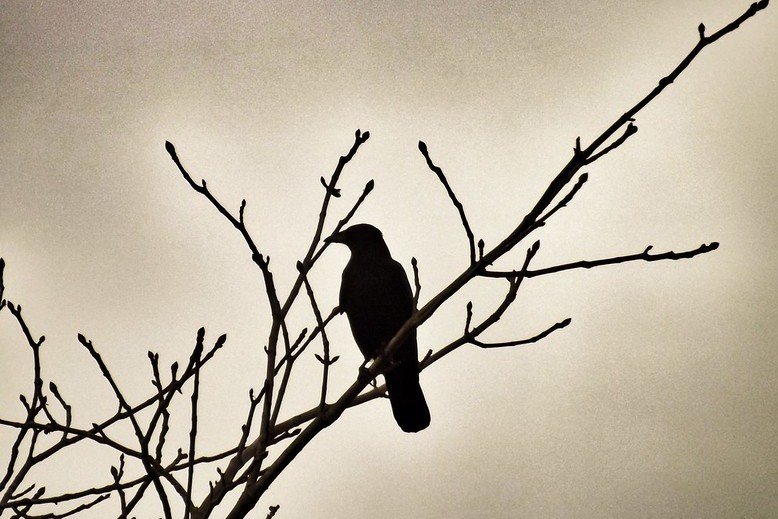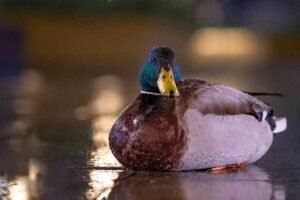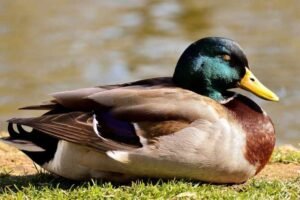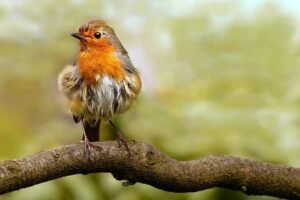At night, birds either forage or find a place to sleep. Nocturnal birds will hunt, while most diurnal birds find refuge in trees or high-lying small holes.
You might be used to seeing birds active during the day, sitting, flying, or looking around for food. When night comes, however, you probably aren’t looking out for birds — but even so, you might hear them chirping as evening approaches or in the early hours of the morning. So where do birds go at night, and what do they do? This article will examine bird behavior during the night hours as well as provide some information on where they like to sleep, gather for warmth, or find food.
Where Do Birds Go At Night?
The short answer to this question is that it depends on the bird. There are some birds that are NOCTURNAL — meaning that they are active at night and sleep during the day. These birds have bodies (eyes, hearing, etc.) adapted to low light, and tend to use the night hours to hunt, mate, or forage.
Nocturnal birds include birds like most owls (of the order STRIGIFORMES), nightingales (LUSCINIA MEGARHYNCHOS), nighthawks (of the subfamily CHORDEILINAE), black-crowned night herons (NYCTICORAX NYCTICORAX), and a few species of parrots and kiwis.
Other birds are DIURNAL — meaning that they are active during the day and sleep (for the most part) at night. For diurnal birds, feeding, nesting, and foraging times are in the day. They tend to take cover or flock together at night to sleep in peace, though they may awaken early at or before sunrise.
Diurnal birds are by far the more common type of bird, including a wide range of raptors, flightless birds, songbirds, semi-aquatic birds, and waterfowl. They may also include birds like hummingbirds, woodpeckers, pheasants, turkeys, grouse, pigeons, and chickens.
At night, nocturnal birds will go to places they can hunt or forage. For example, an owl may soar over an open field to look for mice, whereas a nightingale will forage for insects on the ground in the wooded areas where they live, looking for ants or beetles.
Diurnal birds, on the other hand, will look for safe places to sleep — and this includes places that are far from predators. High trees, holes, or spaces that are located in high places (such as cliffs or buildings) are all suitable for diurnal birds. Behavior and environments may vary, as explained below.
Songbirds : An Example of Diurnal Bird Behavior
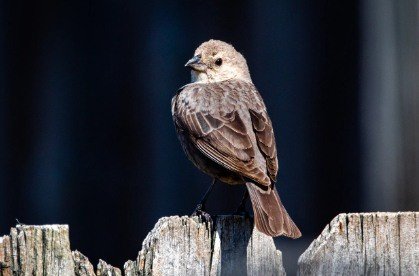
When you think of the question “where do birds go at night?”, you probably aren’t thinking about ostriches or penguins. That is, you are more likely thinking about the behavior of common birds like sparrows, starlings, warblers, or robins.
These species are examples of diurnal songbirds that forage for food during the day and nest or sleep (for the most part) at night. The House Sparrow (PASSER DOMESTICUS) for example, will sleep in the cracks, crevices, and holes of buildings, trees, gas station roofs, clusters of vines, and streetlights.
Songbirds look for places that are high to sleep so as to avoid predators. And not just any high places, either — they really do need to be in a place where they are unlikely to be taken by surprise.
If the House Sparrow takes to a tree for the night, for instance, it will likely avoid a place that is too close to the trunk (to avoid climbing predators like rats or raccoons) or a place too close to the tree’s outer branches (to avoid flying predators like nighthawks or owls).
Songbirds will also sleep in groups and huddle close for warmth. The European Starling (STURNUS VULGARIS), for example, will flock together in large groups at night, either in coniferous or deciduous trees. Individual starlings will change positions at night to help maintain the warmth of the flock.
Songbirds will start chirping once dawn comes or a little before it — but if you hear their songs in the early morning hours, this is likely due to light pollution. Songbirds may get artificial lights or moonlight confused with actual sunlight and begin to sing, even when they would normally sleep.
Waterfowl And Wading Birds

That might be fine for songbirds, you may think — but what about birds that live in different environments? This is a good question, as not all birds are woodland, grassland, or even urban land-dwellers.
Some birds live close to small bodies of water (like ducks and geese), or even larger bodies of water like the ocean (like seagulls or terns). And still other birds live in swamps, marshes, or other low-lying wetlands (like egrets, storks, or herons). Where do these birds go at night?
It turns out that these are diurnal birds as well, meaning they are awake during the day and sleep during the night. If they are far enough out on a body of water, they will sleep on it — if not, they will sleep on land.
The Mallard duck (ANAS PLATYRHYNCHOS), for example, will sleep on a steady body of water at night (or take one of several naps during the day) with its head turned around, rested on its back feathers. It can do the same during the night on land.
The Mallard will keep one hemisphere of its brain functional — with its eye open on that side — to remain partially aware while it rests. Once believed to be particular only to ducks, this is actually a common behavior in many birds.
At night, birds that find themselves near larger bodies of water will sleep on land or water — or even in the air. Frigatebirds (sea-faring birds of the family FREGATIDAE) will sleep with one eye/brain half functional for less than an hour while flying at night during migratory trips.
Wading birds will take to land at night to sleep, or stay with one foot in shallow water (like storks or cranes). The heron will even escape to a tree to sleep at night — all to avoid predators.
Smaller semi-aquatic birds (seagulls, geese, swans, and ducks) will use the intensity of wave patterns to determine when to stop resting if they are on the water, especially at night.
Other Diurnal Birds
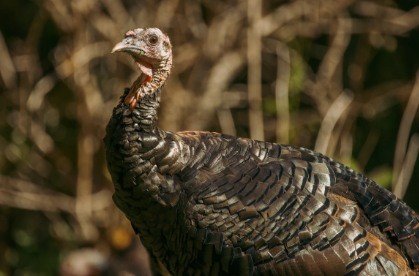
Other diurnal birds display a variety of sleeping behaviors at night but generally keep to the idea of sleeping in places to avoid predation. Wild Turkeys (MELEAGRIS GALLOPAVO) for example, will take to the trees to sleep, while pheasants have been known to do the same.
Ostriches (STRUTHIO CAMELUS) may sit down to rest, but they do not close their eyes. Instead, they undergo measurable REM sleep (and deep sleep) while appearing to be as awake as normal.
Penguins have a variety of sleeping patterns, depending on the species. If they are land-bound, some species will take naps during the day and evening, and remain active the rest of the time. Like other species of birds, penguins may not completely fall into recognizable “deep sleep” at night.
Nocturnal Birds
One answer to the question “where do birds go at night?” could very well be, “to a place to hunt”! This is certainly the case with nocturnal birds like owls and nighthawks. Foraging birds like kiwis wait for the night hours in order for their underground prey — invertebrates — to come closer to the surface.
The Great Horned Owl (BUBO VIRGINIANUS), for example, will hunt during the hours of 8:30 p.m. to 12:30 a.m., with the second period of hunting occurring from 4:30 a.m. to dawn. This owl, native to North America, flies hundreds of feet from perch to perch to look for mammals, birds, and reptiles to eat.
The Common Barn Owl (TYTO ALBA) has a somewhat different approach to hunting at night. Instead of watching from a perch to attack, the Barn Owl will fly low over open territory to look — and more commonly, listen — for small animals (like mice, voles, and birds) to eat.
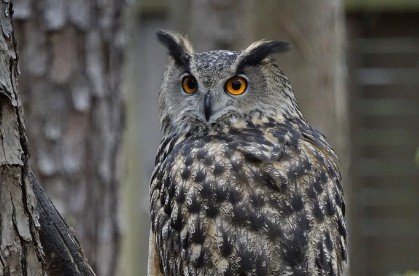
The Common Nighthawk (CHORDEILES MINOR) does not hunt during the main hours of the night, rather it uses the periods just after dusk and right before dawn to hunt insects while flying through the air. The nighthawk also hunts visually and is attracted to light sources with a congregation of insects.
Kiwis (of the genus APTERYX) are nocturnal birds that have an excellent sense of smell. During the night, these New Zealand birds venture out from their burrows to search for insects, worms, fruit, grubs, and plants. They do not have good eyesight and rely on their other senses to feed.
Conclusion
Birds have a variety of behaviors at night, though most birds are diurnal and tend to sleep at night out of the reach of predatory animals. The few exceptions are nocturnal birds, who become active at different parts of the night to hunt, depending on the species.
Smaller birds tend to opt toward higher reaches when night arrives — and will start to chirp once morning comes. Larger birds can similarly take to the trees, or situate themselves on the ground or water. Birds go to a number of places at night, but diurnal birds, they travel to a safe place to rest.

